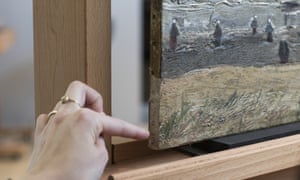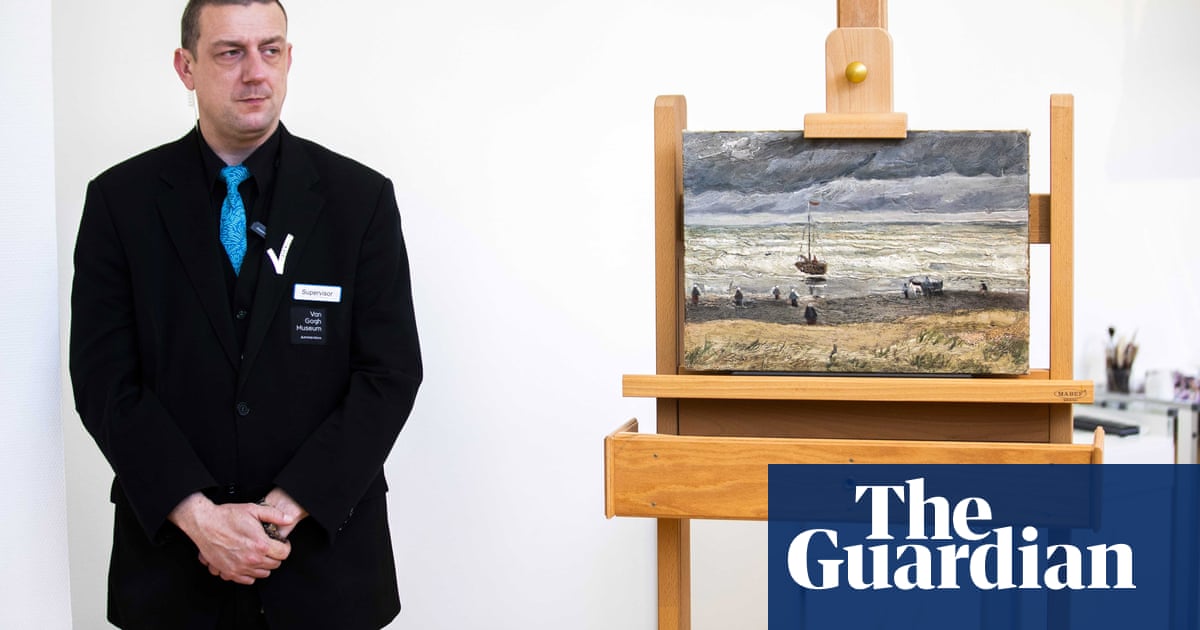Restored paintings go on view in Amsterdam, infamous art heist story to a close
Seventeen years after being snatched from the Van Gogh Museum in Amsterdam, two of the artists works have been put back on public display, bringing the story of one of most infamous postwar art heists to a close.
View of the Sea at Scheveningen and Congregation Leaving the Reformed Church in Nuenen by Vincent van Gogh were stolen in the dark of a December night in 2002.
Octave Durham, now 46, and his accomplice, Henk Bieslijn, climbed on to the roof of the museum using a stolen ladder before smashing a window with a sledgehammer and lifting from a wall the smallest and nearest Van Gogh canvasses they could find. A security guard spotted the men, but she was not allowed to use force to stop them.

The works, painted between 1882 and 1885, were finally recovered in Italy in 2016 and have spent the last two years in the museums conservation studio being restored.
After stuffing the works in a bag, Durham slid down a rope, only to hit the ground with such force that he smashed the seascape painting, tearing a 7cm by 2cm piece from its bottom left-hand corner.
He also dropped his baseball cap, from which the DNA contained in 10 strands of hair would later seal his conviction.
To fill the ripped corner, a scanning technique was used by experts at the Northwestern University in Chicago to measure the thickness of the surrounding paint and the contours of the missing piece.
A comparison was made with a photograph made before the theft, allowing restorers to determine the relief of the surface, which was then reproduced in a 3D-printed mould.
The filling from the mould was then attached to the painting by the conservator, ensuring that it perfectly matched the original brushstrokes. A final retouching was made by hand.
During the restoration, a faint Vincent signature was found, although experts believe it was probably applied by someone other than Van Gogh.

Congregation Leaving the Reformed Church in Nuenen, a gift from Van Gogh to his mother depicting the church where the artists father had been a pastor, was found to have been hardly damaged during the raid, although a varnish added during a 1961 restoration was removed due its yellowing. Both paintings have new frames as the previous ones had been disposed with by the thieves.
Durham, who served a 25-month sentence in 2004 on being convicted of the robbery, told a documentary broadcast in the Netherlands two years ago that the raid had taken about three minutes 40 seconds, and that he had targeted the museum simply because he could.
Thats the eye of a burglar, Durham said. Some people are born teachers. Some people are born footballers. Im a born burglar.
Returning home with the paintings, he had removed the frames and plexiglass cover, which he dumped in a canal. He flushed paint chips from View of the Sea at Scheveningen down the toilet.
He subsequently agreed to sell the painting to the underworld figure Cor van Hout, who had been convicted of the 1983kidnapping of the beer tycoon Alfred Heineken, but the gangster was killed on the day of the transaction, Durham said.

A mafia boss, Raffaele Imperiale, bought the paintings for around 350,000 in March 2003, knowing their provenance and regarding them as a good bargain.
Durhams splurge of all his earnings over six weeks on motorbikes, a Mercedes E320, jewellery for his girlfriend and trips to New York and Disneyland Paris helped detectives, who had been wiretapping the known criminal, who was known as monkey in underworld circles.
Police raided Durhams apartment in Amsterdam but he escaped by climbing up the side of the building before fleeing to Marbella, Spain, where he was arrested in December 2003. Imperiale later wrote to public prosecutors in Naples admitting to having the paintings. They were later found by police in the home of his mother, wrapped in cloth and put away in a concealed wall space.
On announcing the paintings return to the museum, Axel Rger, its director, said: The conservators have done a brilliant job and the paintings will now go back on permanent display in their full glory, for everyone to see.

